Art & Exhibitions
It’s Grim Up North—and Oh So Chic: A New Show Surveys Northern England’s Gritty Impact on Fashion and Culture
We spoke to the curators of "North: Fashioning Identity” about their eye-opening show at London's Somerset House.
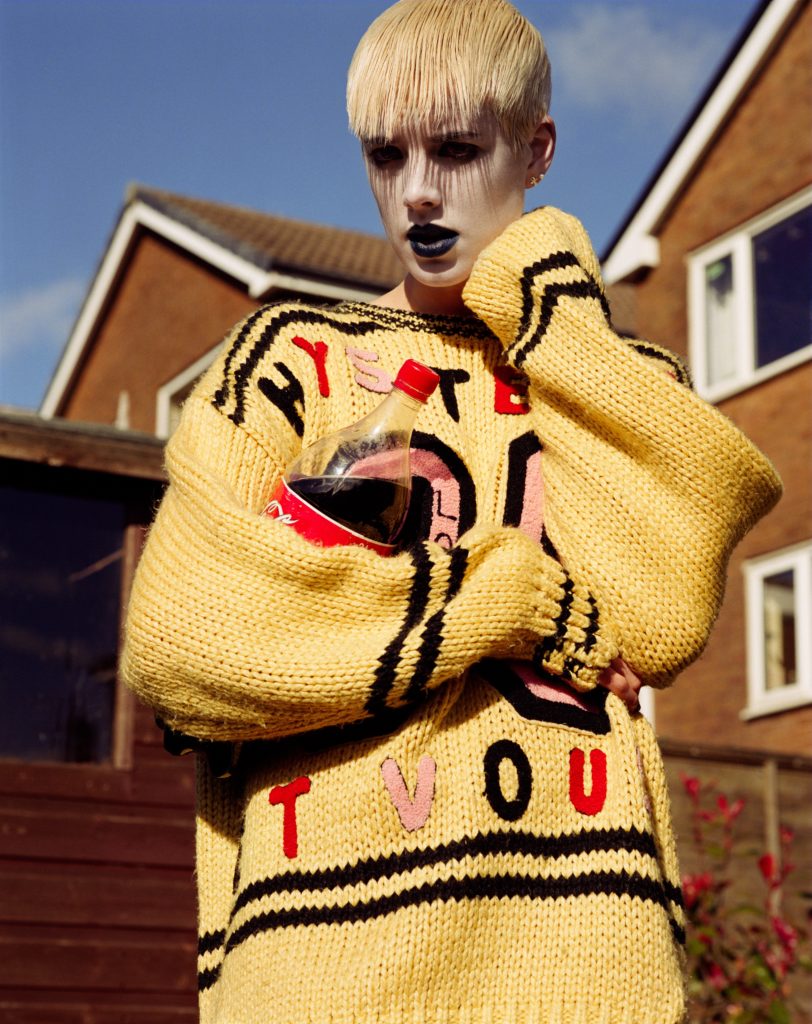
We spoke to the curators of "North: Fashioning Identity” about their eye-opening show at London's Somerset House.

When one thinks of style and attitude in Britain, particularly when it comes to the fragmented identity of a mid-Brexit United Kingdom, most eyes naturally look to London and its vibrant multiplicity. However, a refreshing new photography exhibition at the Thames-side Somerset House called “North: Fashioning Identity” is determined to avert our gaze from the UK’s bustling capital up to its Northern limits. There, decades of simultaneous cultural and industrial development—and then collapse—have sculpted a diverse social stratum, one that has been extensively documented and celebrated through photography, fashion, music, and film.
“It would have been very easy to do a show just about big cities like Liverpool or Manchester,” says the writer Lou Stoppard, who originally conceived the show for Liverpool’s Open Eye gallery this February alongside Manchester School of Art lecturer Adam Murray. “We wanted to show that the North is an eclectic place full of specific geographic and cultural identities and peculiarities. I’m proud of the range–Doncaster, Sheffield, Sunderland, Berwick-upon-Tweed, Yarm, Preston, The Wirral, Rawtenstall, Salford, Bolton, Blackpool, Skelmersdale, Newcastle, County Durham, and Darwen are just some of the places featured.”
Through fashion’s particular lens, “North” unpicks the stereotypes of dress that have proliferated far beyond the humble origins of its geographical subject matter, considering the inspired creations of international fashion designers from Paul Smith to Raf Simons, Gareth Pugh, and Off-White’s Virgil Abloh. Fashion imagery lensed by Corinne Day, Glen Luchford, and David Sims is showcased alongside older documentary photography by the likes of Tom Wood, Shirley Baker, and Peter Mitchell, revealing the real-life inspirations behind fashion’s Northern fix.
“The designer John Alexander Skelton’s MA menswear collection from 2016 is on display, which is actually informed by the earliest work in the show,” explains Murray, referencing a 1930s photograph of the town of Bolton by Humphrey Spender from the archives of the Mass-Observation project, which documented everyday British life in all its facets. “It shows that it is not just the late 20th-century music and sports scenes that have been major influences on fashion design.” Stoppard highlights a film piece by Doncaster-born Alasdair McLellan, created especially for the exhibition. “It’s an epic, rousing, touching piece called Infinity, and it is central to the show,” she said, describing the ambient video piece that splices romanticized footage of skinhead youth with urban and industrial landmarks of the photographer’s hometown.
To better understand the themes of this unexpectedly absorbing show, we spoke to Stoppard and Murray about why they chose such a multidisciplinary exhibition format, and how the hybrid space worked to level the playing field.
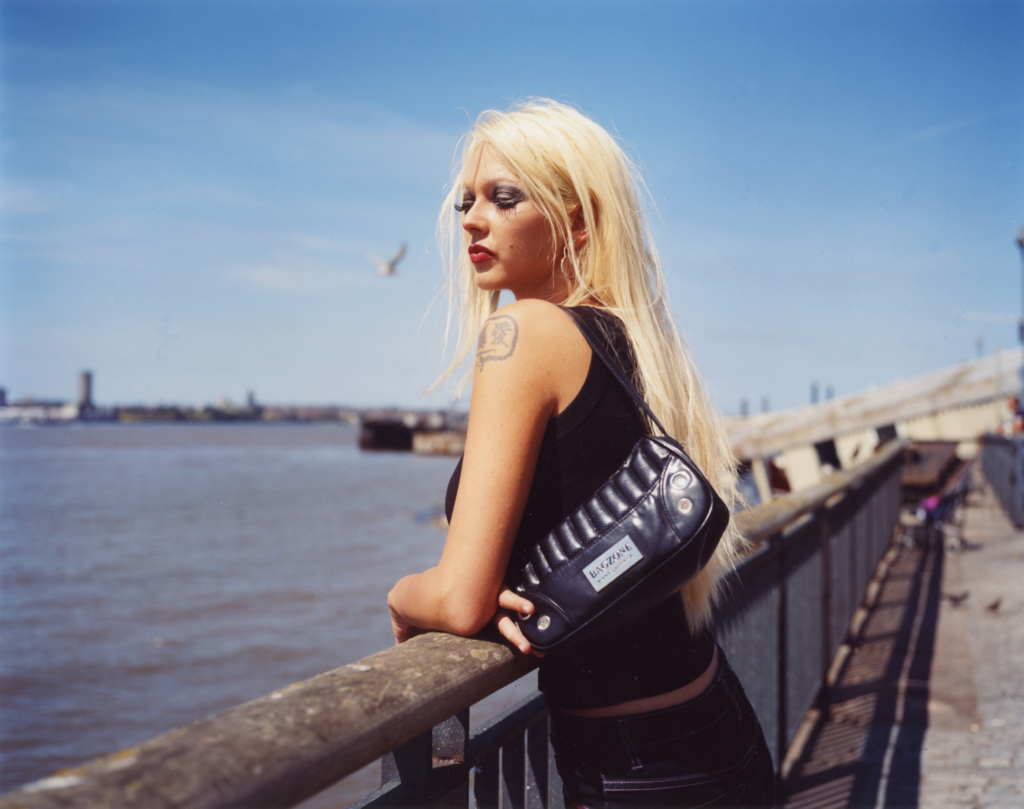
Michelle Sank’sBlaze from the Water’s Edge (2007). Courtesy of Somerset House.
Much of your show is striking for the candid nature of the work. Do you think that “North” exposes attempts by photographers to either glamorize Northern England towards the end of the 20th century, or to exaggerate people’s ideas of what it stands for? Or do you see most works as documentary, reflecting reality?
Adam Murray: I think that “exposes” suggests that we are attempted to uncover something negative, which is not the intention. Clichés and stereotypes are certainly present in the show and something that we acknowledge, but within most of these there is a nugget of truth—the starting point where that image has developed from. The challenge is to identify whether these are still true and present or whether reality has moved on. Most of the work is definitely built on a sophisticated understanding of the visual codes that an audience will be able to recognize, and in some cases this is exaggerated. But this is what fashion imagery tends to do—it takes references from everyday life and develops them into a heightened reality.
Lou Stoppard: Early on in our research, we began to wonder if the North of England is perhaps a bit like New York, Rio, or Paris. Sure, there’s that popular adage that “It’s grim up North!” But as with those bustling, sensual, much-visited, and much-hyped cities, the North is familiar to people who have never actually visited it. It too is defined by an aesthetic reputation—by streets and monuments steeped in literature, art, and popular culture, but also by grey weather and cobbled streets. By smoking chimneys, soot, cloth caps and whippets, clogs and shawls, brass bands, terraced houses, front rooms, washing lines, Wigan Pier, George Formby, Gracie Fields, Coronation Street, Bread, Joy Division, the Haçienda, Madchester, Casual Culture, Shameless, The Royle Family and—a press favorite—bare-legged and coatless women out and about on freezing nights. These are media-generated images that have given way to broader tropes and assumptions. They are stereotypes. But then stereotypes can be true.
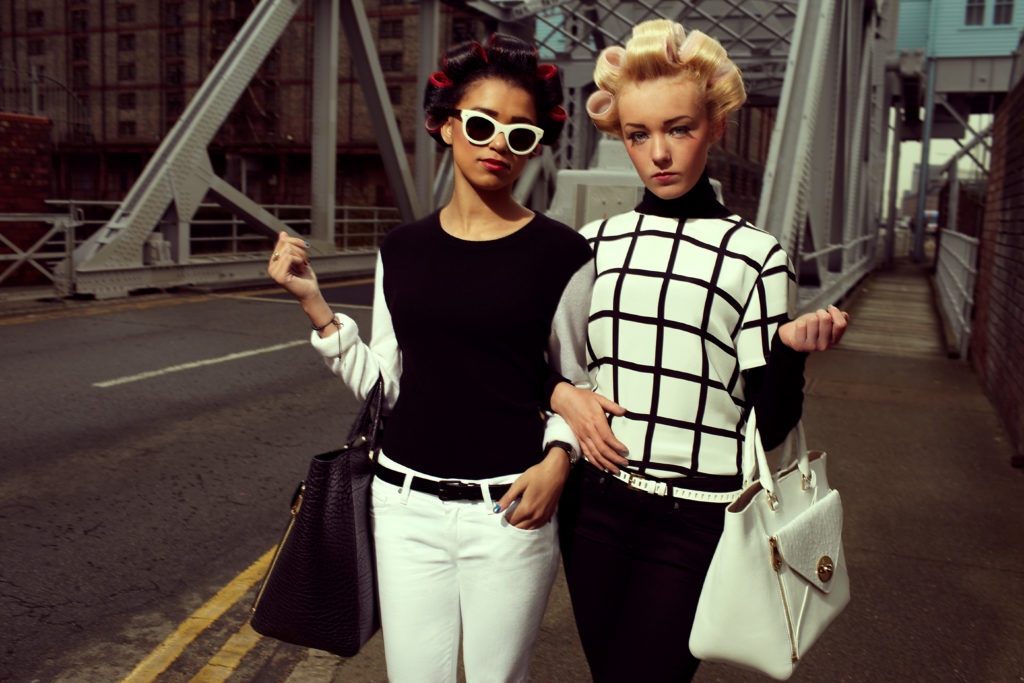
Alice Hawkins’s Derrin Crawford and Demi Leigh Cruickshank in The Liver Birds, LOVE magazine, Liverpool (2012). Courtesy of Somerset House.
Were there other particular time periods that surfaced as a crucial moment in your research aside from the nightlife of the Haçienda, the legendary Manchester club where New Order held sway over seas of drug-enhanced ravers?
Murray: For me, the exhibition shows that each decade or time period from the 1930s—this is where the exhibition starts—has been equally as important as others. For example, the 1930s were a time when the first proper documentation of everyday British life began with Mass-Observation, or the 1970s, when the start of post-industrial period began, which then informed so much of Northern identity today.
Stoppard: I think the ‘80s and early ‘90s and the birth of the style magazines is definitely some sort of turning point, just because that signals the start of a glut of fashion imagery shot in the North or inspired by the North. Images from magazines like The Face form a key part of the show and we spent time considering how these titles approached representations of Northern England.
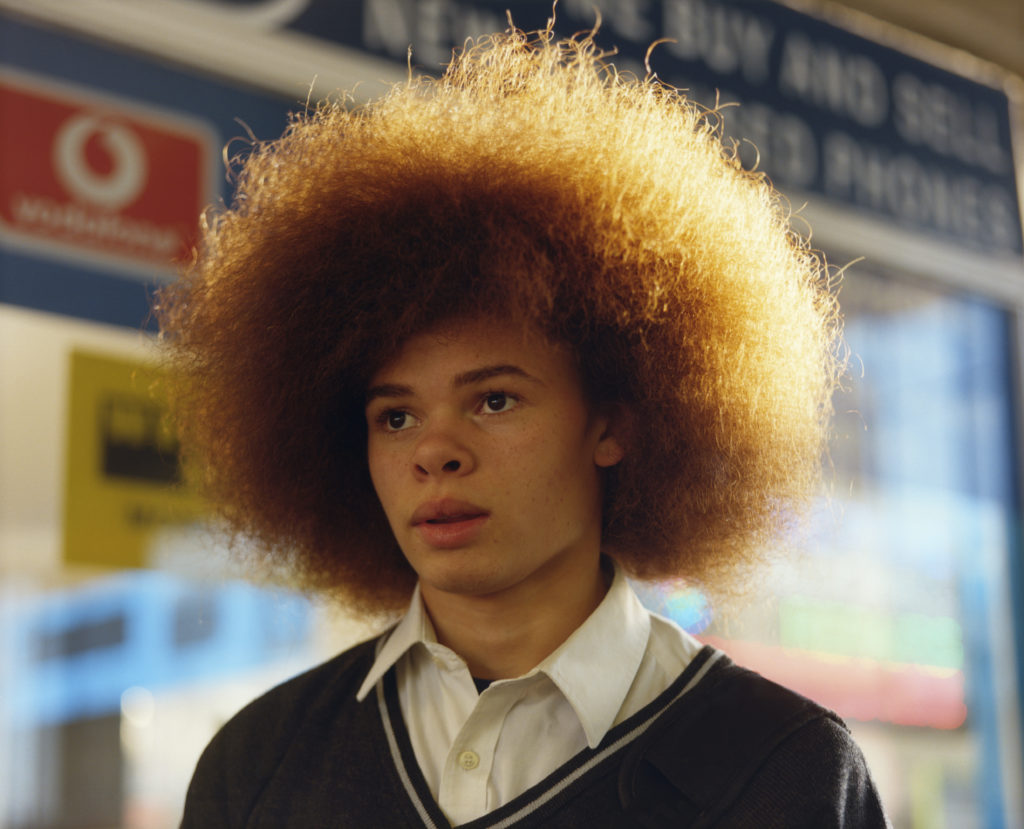
Jamie Hawkesworth’s From Preston Bus Station (2010-2015). Courtesy of Somerset House.
In your research and your discussions with the younger fashion photographers featured in North, have you discovered that they are influenced by the non-fashion documentary photographers that came before them? Are there particular parallels to be drawn there?
Murray: Most definitely. I think most of the younger photographers whose work mainly appears in a fashion context have been influenced by most of the non-fashion photographers, particularly work from the 1980s and 1990s by people like Shirley Baker, Tom Wood, Ken Grant. The exhibition does try to avoid putting each piece of work into a specific genre, though, and encourages each to be viewed on an equal level. Within the more traditional analysis of photography, fashion photography is often seen at the bottom of a credibility hierarchy. This show wants to move away from that so that new dialogues and conversations are created around work that may not normally be seen together.
Stoppard: It was also amusing to draw parallels between work from different generations not just due to the visual motifs or characters contained within them, but also due to the aesthetic or photographic style. Someone like Tom Wood, for example, is adored by photographers like Alasdair McLellan. His work looks utterly current given the mood of fashion photography today—indeed, it’s been reprinted in titles like Love and Dazed recently.
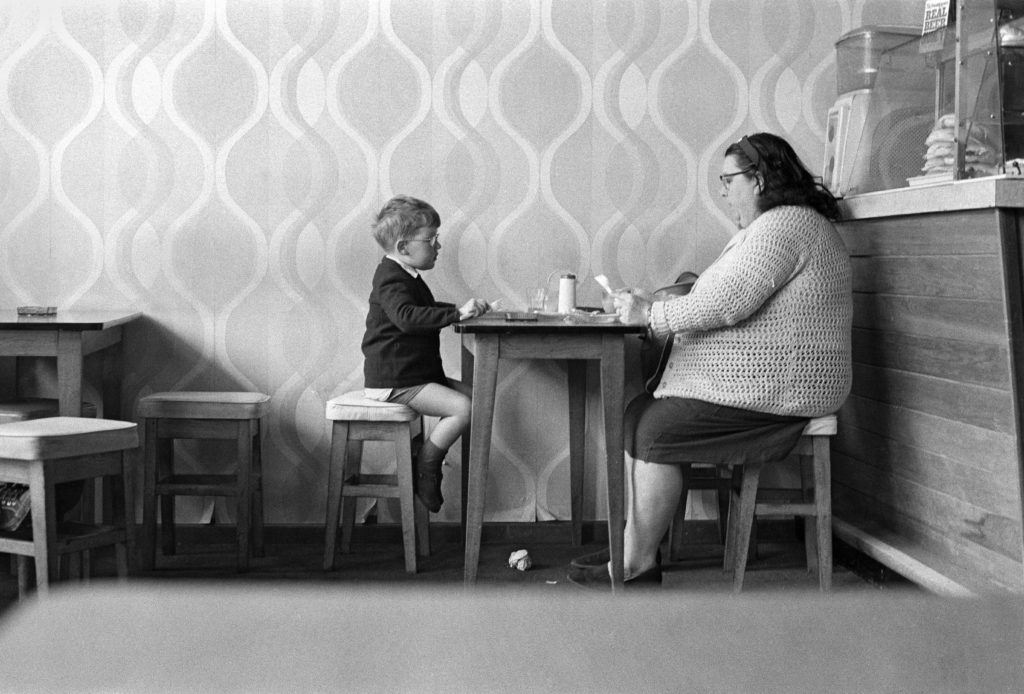
Eric Jacquier’s Gino’s Coffee, Leeds (1969). Courtesy of Somerset House.
How does the show handle social profiling? Does it approach the middle and upper classes as well as working class life?
Murray: The starting point of this show is the influence of the North of England on fashion, so our choices of what to include were informed by this and for sure, a lot of the culture that fashion references is related to visual codes that would be associated with working class life in England. However, some of the contributors with a lot of work in the show who have done detailed interviews, such as Alasdair McLellan and Christopher Shannon, do talk about how they identify as middle class, and how their own experiences have informed their work.
Stoppard: It would be impossible to do a show that considered the North/South division in England without considering class and wealth. While the show looks at aesthetics, perhaps people will interpret that there’s an underbelly to it that exposes deep set differences in opportunity, lifestyle, and politics. We conceived the project long before Brexit, but that it occurred during the curating process has of course made us think keenly about a nation split—the agitation around differences in dreams, hopes, hardship, or lifestyle certainly gave us food for thought.
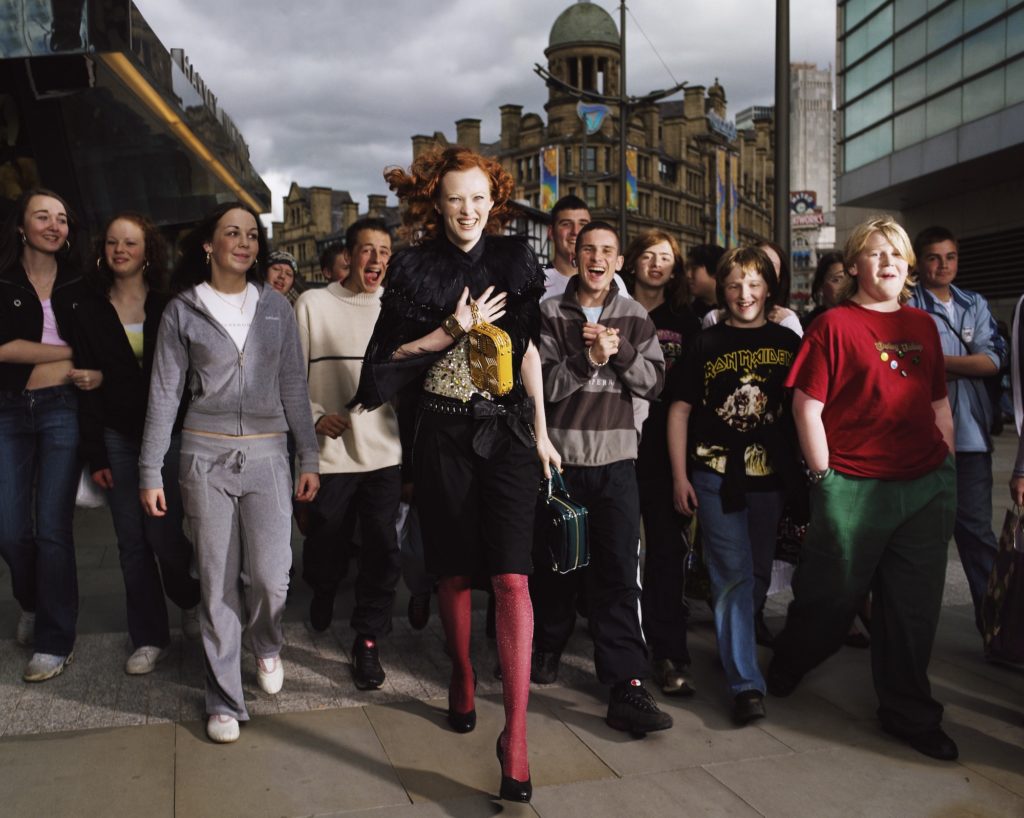
Elaine Constantine’s Karen Elson (2005). Courtesy of Somerset House.
How did you approach the installation of physical objects in what is essentially a photographic show, especially in regards to exhibiting fashion? What do you think is the best way of showing clothing in an art context, in terms of the viewer experience?
Murray: From the outset Lou and I agreed that it was vital to include other items beyond just photography. This includes moving image, sound pieces, printed magazines, and clothing. Personally I’m never usually a fan of shows that display clothing on formal mannequins or behind screens. While I appreciate the necessity of this at times, for me it ruins the close, tactile relationship that people have with clothing. Therefore, we wanted to develop a display system that both hinted at overarching themes in the exhibition as well as allowing audiences to be as close to the clothing as possible.
This was achieved by working with the wonderful set designer Tony Hornecker. He really has transformed the more object-heavy sections of the show. In the show’s first incarnation at Open Eye Gallery in Liverpool, Tony displayed clothing in a room that hinted at a sports changing room. This theme is maintained in Somerset House, but the extra space has allowed him more room for creativity. One of my favorite examples is the tree-like structure that he made from found tools and wood from a car boot sale. John Alexander Skelton’s garments then hang from the ‘branches.’
Stoppard: Given the exciting opportunities for displaying images and objects online now through amazing digital channels you really have to give people a reason to go to a physical space, and I enjoy considering the visitor experience. There are several long-form video interviews in the final room of the show, and Hornecker has created wonderful environments in which to watch them that nod to the themes of each film—a bedroom, a cinema, a front room, a karaoke bar. That means visitors become a part of the exhibition and the installation, acting out routines of Northern life. They become the work. I think it’s vital not to put photography in one box, and art in another, and music in another, and fashion in another. As this show highlights, whatever their chosen field, practitioners are influenced by similar formative experiences or key moments in pop culture. You can’t separate the work out just because of differing media.
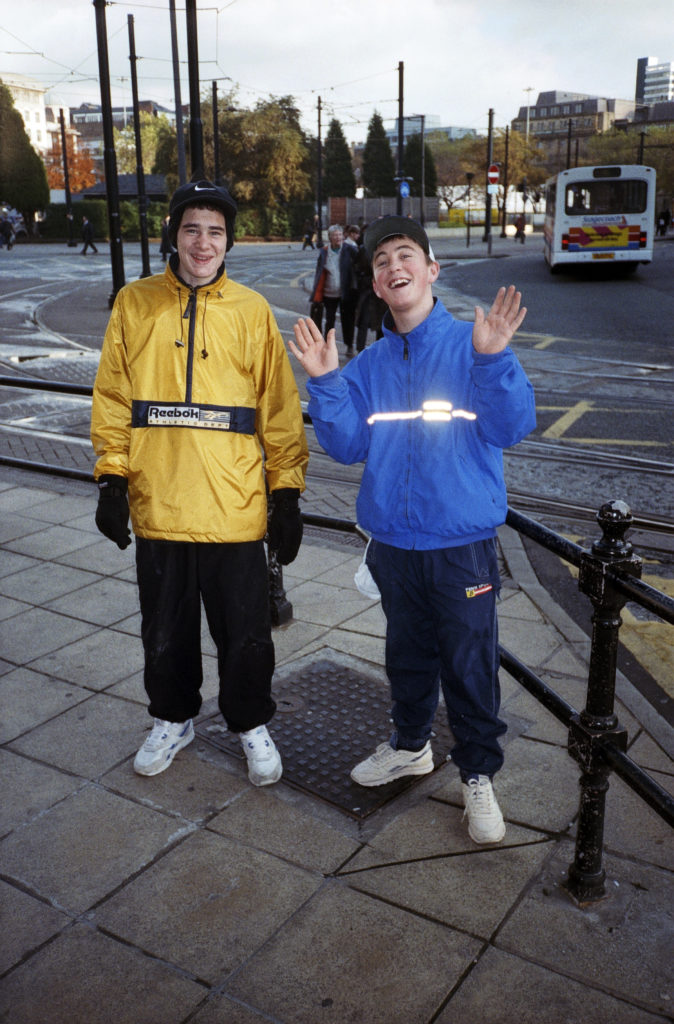
Jason Evans’s Untitled, Manchester (1997). Courtesy of Somerset House.
In terms of representing a region and its culture, what elements became most glaringly evident to you to explore and represent when compiling this show? Was it music? Was food important? What about romance and courting, and the difference between domestic, built, and natural environments?
Murray: All of the above are vital no doubt. Lou and I had to maintain a careful balance between themes such as music and sport which are so prevalent amongst a lot of work, with themes that are often overlooked. One of these is the rural, as so much focus is often on urban centers. Each room at Somerset House is based on a loose theme, but these have not been titled and are not meant to be seen as separate sections. Each flows into the other as it does in the work. It’s interesting that you bring up food and romance. These are less explicit in the work but clearly something that resonates strongly with viewers. I think that’s one of the joys of the exhibition—everyone who visits will be able to pick out details or more subtle themes that they can relate to.